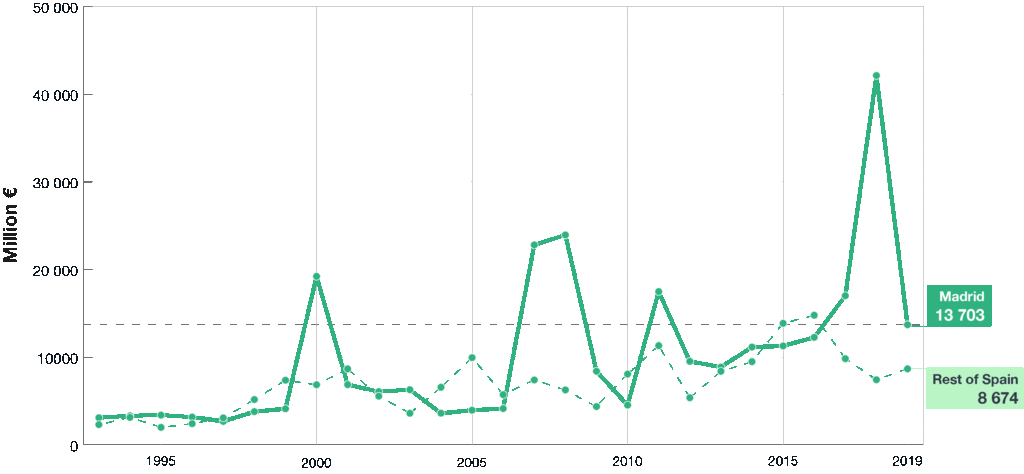
Productive Foreign Direct Investment (FDI) flows received by Spain have undergone a significant correction in 2019, falling to 22.37 billion euros, according to recent data from the Investment Registry. Despite the magnitude of the downturn compared to the previous year (-54.8%), the figure was in the range of the annual averages registered by Spain in the last decade. Moreover, the correction was expected, in the absence of cross-border corporate operations of the size of those registered in 2018, the year in which the historical investment maximums had been reached, both in gross and net terms. It is also important to put this figure in a global context: 2019 has been the fourth consecutive year of decline in global investment flows, in a context of weak economic growth and deepening trade tensions. The prospects for the next two years are not rosy either, with international sources such as UNCTAD predicting declines of between 30% and 40% due to the impact of the COVID-19 pandemic.
At this juncture, Madrid was the destination of more than 61% of the investment received by Spain in 2019, slightly above its average of the last decade (60.6%), and once again accounting for the lion’s share of the national registers. The region has chained six consecutive years receiving more than 10 billion euros a year, its historical average since 1993, with investments registered rising to 13.7 billion for 2019. Despite the marked decrease compared to the previous year, it is the fourth best figure since 2009.
Evolution of FDI flows received by Madrid, 1993 – 2019, Millions of euros

Source: Compiled by the authors, based on Investment Registry figures, March 2020
As was anticipated in previous notes, the foreign investment series tend to be very volatile, as annual figures can be distorted by a few specific large-scale operations. Madrid, as the headquarters of many of the main national companies, experiences this phenomenon when any of these companies is the subject of a total or partial cross-border acquisition. This has been the case in 2000 and 2011 (corporate operations in the telecommunications sector), 2007 and 2008 (energy and tobacco sector) and 2018 (transport and storage). In 2019, there were hardly any operations above 1 billion.
Madrid receives productive investment flows mainly from other OECD countries (91% of productive flows since 1993). Among them, Spain’s European partners continue to be the main source, with the EU-15 countries responsible for 71% of total flows since the beginning of the century. Among non-EU countries, only the United States (second) and Mexico (ninth) have been among the top 10 investors in Madrid since 2000, although the United Arab Emirates (eleventh), Canada (twelfth) and China (thirteenth) have had a greater role since 2009, especially the last two.
2019 was a year in which the country of origin of investments in Madrid was once again been very spread out, with just three countries (France, the United States and the United Kingdom) exceeding 1 billion in investment. This contrasts with the previous year, in which, beyond the Abertis macro-operation, eleven countries exceeded the 1 billion threshold.
France led investment in Madrid in 2019, with 3.1 billion euros (23.0% of the total), its second best record since 1993, more than doubling its figure for the previous year, thanks to heavy investments in Financial Services (953 million), Advertising and market research (584) and Activities auxiliary to financial services (530 million). The United States, after its historical investment record in 2018, returned to levels close to its average of the last decade, with 2.57 billion invested last year, 19% of the total. Investments in Financial Services (779 million) and Insurance (an additional 309 million) stand out, with four other sectors exceeding 100 million. The United Kingdom, for its part, also reduced its flows from the previous year to 1.96 billion (14% of the total), with a significant weight of investments in Advertising and market research (683 million) and Education (422 million, all of them in University Education).
The list of main investors in 2019 ends with Mexico (785 million, the highest in its historical series, thanks in part to its heavy investments in Financial services), Italy (682 million, well above its average since 2009, but still a considerable decrease compared to the excellent figures reported in 2018), Spain (656 million in circular investments from subsidiaries of Spanish companies abroad) and Canada (440 million, consolidating itself among the main investors in the region, this year with strong investments in Electric Power Supply).
The sharp decreases registered in the following three countries stand out: Germany (-75%, down to 393 million), the Netherlands (-64%, down to 325 million) and Luxembourg (302 million, -66%), although these last two countries continue to play a fundamental role as countries of transit that are fiscally convenient to channel investments from other countries. Indeed, 49.8% of the investment received by Madrid in 2019 came through one of those two countries: 5.48 billion through Luxembourg, and 1.34 billion through the Netherlands. Luxembourg has played a key role for investments from France, the United States, the United Kingdom, Canada, Sweden or Germany, while the Netherlands has channeled investments from the United States, South Africa and Argentina, fundamentally.
Although they do not rank among the top ten investors, the increases in investment in 2019 of countries such as Sweden, Switzerland, Russia or Panama are significant, although from relatively low previous levels.
In line with the growing weight of the tertiary sector of the large metropolitan areas, the Services sector has traditionally accounted for the bulk of the foreign investment received by Madrid. Since 1993 it has concentrated over 68% of the flows received, a percentage that rose to 72.5% of the total in the last cycle (2009-2019). The industrial sectors, meanwhile, have been losing prominence (from 31.5% between 1993 and 1999 to 17.3% of the investments received since 2009), while construction has remained at around 8% in the last decade.
As was the case with geographical origin, the investments received by Madrid in 2019 are also more spread out among the different sectors than the previous year. In 2019, only four sectors exceeded 1 billion euros of investment received, accounting between them for 49% of the total.
Financial Services ranks first (2.8 billion, 20.8% of the total, mainly from France, the United States and Mexico), with notable investments in Other credit activities (1,012 million), Other financial services (997 million) and Other forms of financial intermediation (807 million). The Real Estate activities sector also stands out with 1.48 billion, 11% of the total, coming largely from France, Germany, the United States and Italy), with Real Estate Rentals (922 million) standing over Management of real estate (329 million).
Advertising and market research ranks third , with 1.28 billion invested in the year (9.4% of the total), with a significant weight of Market research (670 million, mostly from France) and Advertising agencies (613 million, almost entirely from the United Kingdom). Other sectors that have exceeded the billion euros mark are Activities auxiliary to financial services (1,097 million), with a strong representation both of Other auxiliary activities (693 million, largely from France and Spanish subsidiaries abroad) and of Intermediary activities in securities operations (330, about half from Argentina).
Also noteworthy, though these are sectors that didn’t reach the 1 billion mark for the year, are Electricity Supply (741 million), Telecommunications (689 million), Education (428 million) and Wholesale and Retail Commerce (388 million).
Complementary information regarding the flow data of the Investment Registry is offered by the data on greenfield investment projects (investment in new plants) compiled by fDi Markets. According to its latest records, Spain received 3% of the total projects announced globally between 2003 and 2019, but it has come to occupy one of the top positions in the worldwide ranking in recent years.
In 2019, Spain received 813 greenfield projects, of which 189 were in the Madrid region, after an increase of 26% over the previous year. That figure represents the maximum since this source compiles data, and it has also been accompanied by maximums in the volume of investment announced (3,256 million dollars, 27% more than 2018) and employment (18,932 jobs, 78% more than the previous year).
As previous posts have shown, Madrid stands out in its ability to attract productive foreign investment, leading practically all the indicators related to FDI in Spain. The prospects for 2020 and 2021 are negative, globally and in particular in Spain, both due to the ongoing health crisis and to previous doubts about the global economy, the intensification of international trade tensions and their expected impact in the reconfiguration of global value chains and the increase in protectionism (Spain has been one of the last countries to tighten its procedures for monitoring foreign investment, following the guidelines set by the European Commission). In this context, it will be more important than ever to carry out an exhaustive follow-up of the evolution of the investment operations that take place, as well as an in-depth analysis of Madrid’s value proposition and international positioning.
To learn more about foreign investment in Madrid, we recommend you consult the following articles and previous monographs: